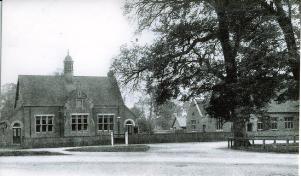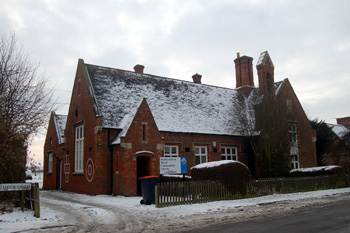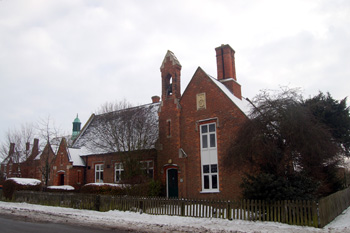Cardington School

Cardington School around 1900 [Z50/24/76]
A new school was built by William Henry Whitbread in 1849 (as reported in the Bedfordshire Times) as a Parochial School and was used by both boys and girls in separate departments. An Inventory of books and apparatus from 1852 [SDCardington2] included a school library consisting of 60 volumes; 8 large maps (World, Europe, Asia, Africa, America, England, Ireland, Scotland) and slates for writing on.
The first Education Act was passed in 1870 (more correctly it was known as the Elementary Education Act). It was a milestone in the provision of education in Britain demonstrating central government's unequivocal support for education of all classes across the country. It also sought to secularise education by allowing the creation of School Boards. These were groups of representatives, elected by the local ratepayers and the Board had the powers to raise funds to form a local rate to support local education, build and run schools, pay the fees of the poorest children, make local school attendance compulsory between the ages of 5 and 13 and could even support local church schools, though in practice they replaced them, turning them into Board run schools (known as Board Schools). Naturally, and luckily for local historians, the Act required a questionnaire of local schools in 1870. The questionnaire for Cardington noted that there was accommodation for 97 children.
In the school log book entry for 9th October 1871, Elizabeth Anna Morris took charge of the school. She found that standards were poor and thought that the children "excessively talkative". The national School Inspector's Report later that year was encouraging but things had not improved by the time John Widdicombe began as Master on September 15th 1873. He found the children "very backward" and the school "very disorderly". In the Inspectors report 1875 the school lost two tenths of its grant for poor results and discipline. Fortunately, by the Inspectors report of 1876 considerable improvement had been shown [SDCardington10].

The former Cardington School Christmas Eve 2010
A land mark Education Act was passed in 1902, coming into effect in 1903. It disbanded the School Boards and gave day to day running of education to newly formed Local Education Authorities, usually the county council, as in Bedfordshire. The old Board Schools thus became Council Schools whilst the old National, British and other non-Board schools became known as Public Elementary Schools. Cardington became a Public Elementary School. At the time of the changeover [E/SA3/1/2] it consisted of two departments, infants and juniors, the school overall had 42 infants and 74 juniors on the role and an average attendance of 92. The school buildings belonged to Samuel Whitbread. The 1901 Inspector's report noted that in the mixed junior school "Discipline is satisfactory, and some very creditable work has been done in classes taught by the Headmaster, but there has been a marked falling off in the lower division". In the infants school "The methods of teaching are unskilful and ineffective…the discipline and order unsatisfactory. These defects are so serious that the class must be reported inefficient". By the 1902 Inspector's Report things had improved somewhat as it noted of the juniors that "…the general efficiency of the School is only fair. The order throughout should be more precise and habitual. the elder children are quite ignorant of History, and in the lower division the work is unsatisfactory". As for the infants "Progress…is effected by faulty classification, and, owing to inattention and answering out of turn the Object Lessons are ineffective, but the teaching is very careful and diligent". Staff in 1903 comprised:
George Edward Coggins, aged 46 (appointed 1879) - headmaster;
Gertrude Stanbridge, aged 30 (appointed 1903) - junior teacher - the current teacher. Miss Partridge, was "not "approved" by H.M.Inspector, and therefore leaving";
Miss Vincent, aged 30, but she was leaving for Elstow School and a successor had not yet been appointed.
Bedfordshire & Luton Archives & Records Service has a scrapbook of cuttings of visits made to most Bedfordshire Schools by School Inspectors for a period from just before the First World War through the inter-war years [E/IN1/1]. The School Inspector's report for 1911 noted that the Infants Class was the best feature of the school, with reading being particularly good and, though the older children were taught generally satisfactorily more work had to be done with the younger juniors. An epidemic had broken out prior to the Inspector's visit in 1913 but a good standard of work was noted, with the infants, once again, doing the best, though improvements had also been made in the teaching of the juniors. The First World War saw a few changes in the everyday routine of the school including the loss of the annual Whit week holiday in June 1916 and the excitement of 18th Jan 1918 when: " a new airship passed over here this afternoon, about 3 o’ clock, and all the children were taken out to see it" [SDCardington11].
After 1913 another inspection was not made until 1923 which from 1913 to 1921 "had deteriorated in efficiency very seriously" but the new headteacher had made substantial improvements. Other reports made between the wars continued to be good. In 1925 it was noted that "the school has a good tone and the children, especially in Class1, work diligently"; the infants were "doing very well indeed…the diffidence noted in the last Report has to a large extent disappeared". In 1932 it was reported that a new Head Mistress had taken over in 1929 and that in 1930 the school had been "decapitated", losing its Infants Department "The teaching of Arithmetic and attention to Speech Training perhaps show the most strikingly successful results in a school where every subject is most carefully taught…" In 1936 the inspector noted of "this most efficient school" that "The Head Mistress and her Assistant may therefore be complimented on work which has been well tested for years, and organisation and friendly relations which proved invaluable on this occasion".

The former "offices" at Cardington School September 2007
During World War Two Air Raid Drills were held in school, on May 10 1940 it was noted in the logbook that every child was undercover in 5-6 minutes. When VE day was announced there was a two day holiday and on May 10th 1945: "A Thanksgiving Service was held on opening school. Time-table rearranged so that the day could be appropriately marked. National songs and dances were enjoyed. Children described their VE day experiences – a day of general rejoicing together". [SDCardington12].
The third of the great Education Acts was that of 1944 which established the principle of County Primary Schools for children up to the age of 11, at which time they took an examination to determine the nature of the secondary school they would attend until they were 15, the most academically able going to grammar schools, the rest to secondary or secondary modern schools. Cardington became a County Primary School for children aged 5 to 11. The School Inspector in 1951 [E/IN1/2] noted that the school contained 63 children, 45 of whom came from RAF Cardington and had been admitted to relieve congestion on Eastcotts County Primary School. "Enlightened teaching methods" were in use amongst the juniors but the infants "while sympathetically handled, do not have the opportunities of enjoying such stimulating experiences". The Inspector in 1959 reported that the school now had 48 pupils, having had 150 in the previous year, many from RAF Cardington, but that these had been transferred to the new school at Shortstown. A new sanitary block had been built in 1953 and, despite good efforts "a number of children in the school …are slower in learning to read than might be expected…the experiment of leaving the more backward children in the lower class seems not to have succeeded". Despite some concerns over reading it was reckoned that "Throughout the school there is a confident relationship between teachers and pupils" and that "The school is serving its village well".

The rear of former Cardington School September 2007
In the 1970s Bedfordshire County Council introduced comprehensive education, doing away with the 11+ examination and grammar schools and introducing a tier of school between the old County Primary and County Secondary Schools. Thus Lower Schools now taught children aged 4 to 9, Middle Schools from 9 to 13 and Upper Schools from 13 onwards. The school became a Lower School but it was closed in July 1983 as an economy measure due to its small size. The buildings are now [2006] used as one of its three countywide offices by Bedfordshire Rural Communities Charity.

Ther former Cardington Lower School Christmas Eve 2010